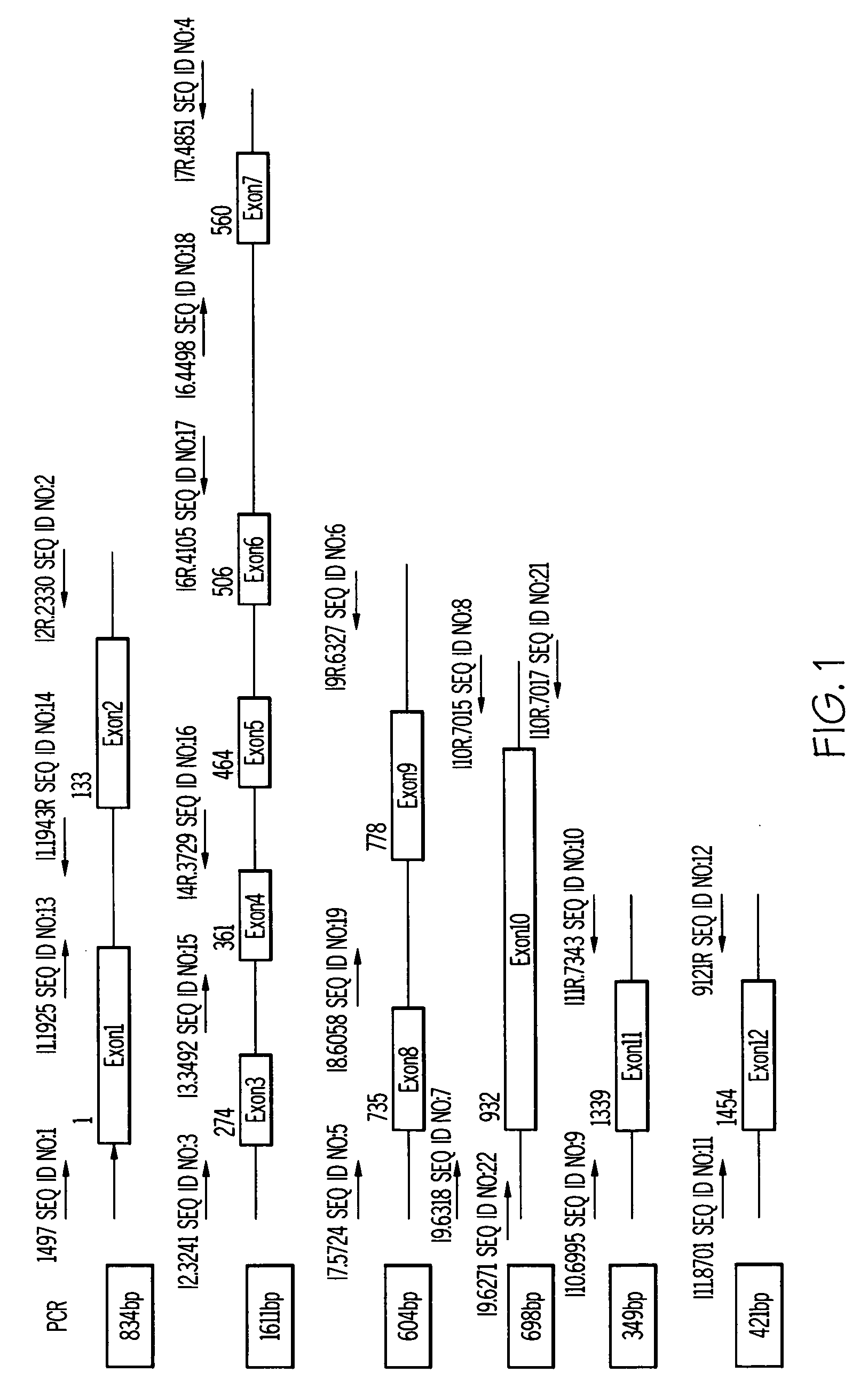Diagnostic assay for Wiskott-Aldrich syndrome and genetically related disorders
a genetic disorder and diagnostic assay technology, applied in biochemistry apparatus and processes, fermentation, organic chemistry, etc., can solve the problems of difficult clinical definition, low platelet count, patients with significant bleeding risk and susceptibility, and achieve the effect of minimizing labor and equipment requirements
- Summary
- Abstract
- Description
- Claims
- Application Information
AI Technical Summary
Benefits of technology
Problems solved by technology
Method used
Image
Examples
example1
Extraction of DNA from Whole Blood
[0037] Puregene DNA isolation kit (Gentra Systems, Minneapolis, Minn., USA)was used for genomic DNA isolation from blood and other tissues. All reagents were provided by the kit. Whole blood was collected from a patient. The blood was collected in EDTA tubes or ACD tubes to prevent the blood from clotting and to reduce DNA degradation. Fresh blood samples were stored at 2-8° C. for up to 7 days. In some instances whole blood was frozen immediately and stored frozen until use.
[0038] Enucleated red blood cells were removed from the whole blood sample by lysis. Red blood cell lysis solution (9 ml) was placed in a 15 ml tube. Two to three ml of whole blood were added to the red blood cell lysis solution. The tube contents were mixed by inversion and incubated for 10 minutes at room temperature. The tube was centrifuged for 10 minutes at 2,400 rpm.
[0039] The supernatant was removed leaving a visible white pellet containing white blood cells and residu...
example2
Oligonucleotide Synthesis
[0044] Oligonucleotides having the nucleotide sequences set forth in SEQ ID NOS:1-19, and 21-22 were designed. The oligonucleotides were synthesized by a commercial source. The synthetic oligonucleotides were resuspended at a concentration of 100 μM. The oligonucleotides were resuspended in water.
example 3
Enzymatic Amplification of Multiple Regions of the Wiskott-Aldrich Syndrome Protein Gene
[0045] PCR amplification is a process sensitive to contamination. Therefore PCR appropriate procedures were used to minimize the risks of contamination.
[0046] Master mixes for the PCR reactions were prepared. Master mixes contained 1.5 mM MgCl2, 1× PCR buffer (Life Technologies Inc.. Rockville, Md., USA), 0.2 mM dNTPs, 1.5 units Taq polymerase, 0.4 μM 5′ primer, and 0.4 μM 3′ primer. The master mix was prepared for the desired number of reactions plus two. Separate master mixes for each oligonucleotide pair were prepared.
[0047] PCR tubes were placed on ice. Aliquots of the master mix were transferred into the PCR tubes. Template DNA at 0.5 μg / reaction was added to each tube. The reaction tubes were placed in a thermocycler and the power was turned on. The PCR incubation conditions for the incubation periods were: 95° C., for 5 minutes; 35 cycles of 95° C., for 45 seconds, 57° C., for 45 second...
PUM
| Property | Measurement | Unit |
|---|---|---|
| Temperature | aaaaa | aaaaa |
| Temperature | aaaaa | aaaaa |
| Temperature | aaaaa | aaaaa |
Abstract
Description
Claims
Application Information
 Login to View More
Login to View More - R&D
- Intellectual Property
- Life Sciences
- Materials
- Tech Scout
- Unparalleled Data Quality
- Higher Quality Content
- 60% Fewer Hallucinations
Browse by: Latest US Patents, China's latest patents, Technical Efficacy Thesaurus, Application Domain, Technology Topic, Popular Technical Reports.
© 2025 PatSnap. All rights reserved.Legal|Privacy policy|Modern Slavery Act Transparency Statement|Sitemap|About US| Contact US: help@patsnap.com

